Fourth Quarter Year-over-Year Highlights:
-
Completed $70 billion acquisition of Aetna
-
Revenues(1) increased 12.5% to $54.4 billion
-
GAAP diluted earnings (loss) per share from continuing operations of $(0.37), including a $2.2 billion, or $(1.99) per share, goodwill impairment charge related to the Long-Term Care (“LTC”) business
-
Adjusted EPS of $2.14
Full Year Highlights:
-
Revenues(1) increased 5.3% to $194.6 billion
-
GAAP diluted earnings (loss) per share from continuing operations of $(0.57), including $6.1 billion, or $(5.89) per share, of goodwill impairment charges related to the LTC business
-
Adjusted EPS of $7.08
-
Generated cash flow from operations of $8.9 billion; free cash flow of $6.8 billion
2019 Guidance:
-
GAAP operating income(1) between $11.7 billion to $12.1 billion
-
Adjusted operating income(2) between $14.8 billion to $15.2 billion (excludes amortization of intangible assets)
-
GAAP diluted EPS from continuing operations in the range of $4.88 to $5.08
-
Adjusted EPS in the range of $6.68 to $6.88
-
Cash flow from operations between $9.8 billion to $10.3 billion
WOONSOCKET, RHODE ISLAND, February 20, 2019 - CVS Health Corporation (NYSE: CVS) today announced operating results for the three months and year ended December 31, 2018.
President and Chief Executive Officer Larry Merlo stated, “2018 was a milestone year for CVS Health as we successfully completed our transformational merger with Aetna, began effective implementation of our integration strategy, and took important steps toward building the integrated healthcare model that will bring substantial value to our various stakeholders. We had strong financial performance and delivered on our operating expectations.”
“With the completion of the Aetna acquisition, we have set the stage for CVS Health to excel in a market that is rapidly transforming. We strongly believe in the long-term value that the full breadth of our capabilities can provide. Our unique combination will drive above-market growth going forward across all of the enterprise. Maintaining our focus on community-level products and services will drive meaningful value for both consumers and payors, while improving our bottom line and the value we return to shareholders. Ultimately, our open platform model allows us to meet the needs of all payors with newly created products and services. We’re more excited than ever about the opportunities that lie ahead.”
1 Effective for the fourth quarter of 2018, interest income was reclassified from interest expense, net to net investment income within revenues to conform with insurance company presentation. Accordingly, revenues and operating income have been revised for all prior periods presented to conform with the current presentation. See Supplemental Information starting on page 15.
2 In 2019, adjusted operating income will also exclude the amortization of intangible assets. See Supplemental Information on page 21.
Consolidated Fourth Quarter and Full Year 2018 Results
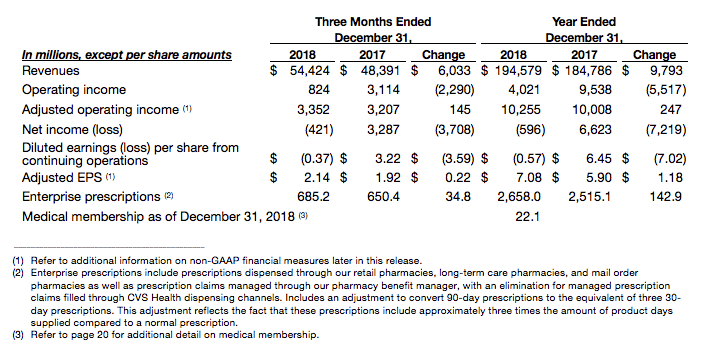
-
As a result of the acquisition of Aetna Inc. (“Aetna”), which closed November 28, 2018, the Company established a new Health Care Benefits segment, which is the equivalent of the former Aetna Health Care segment. Certain aspects of Aetna’s operations, including products for which the Company no longer solicits or accepts new customers, such as large case pensions and long-term care products, are included in the Company’s Corporate/Other segment.
-
Revenues increased 12.5% and 5.3% for the three months and year ended December 31, 2018, respectively, compared to the prior year. Revenue growth was primarily driven by increased pharmacy network claims in the Pharmacy Services segment, increased prescription volume in the Retail/LTC segment and the addition of Aetna. The increase was partially offset by continued price compression in the Pharmacy Services segment and reimbursement pressure in the Retail/LTC segment, as well as increased generic dispensing.
-
Operating income declined in both the three months and year ended December 31, 2018 compared to the prior year primarily due to the goodwill impairment charges in the Retail/LTC segment discussed below.
-
Adjusted operating income increased 4.5% and 2.5% for the three months and year ended December 31, 2018, respectively, compared to the prior year. Earnings growth was primarily driven by increased prescription volume, improved purchasing economics and the addition of Aetna, partially offset by continued price compression in the Pharmacy Services segment and reimbursement pressure in the Retail/LTC segment.
-
Net loss for both the three months and year ended December 31, 2018 was driven primarily by the goodwill impairment charges in the Retail/LTC segment discussed below, the majority of which are not deductible for income tax purposes, and the increase in interest expense due to the 2018 financing associated with the acquisition of Aetna.
-
The effective income tax rate was 517.1% and 142.4% for the three months and year ended December 31, 2018, respectively, compared to (17.0)% and 19.8% for the three months and year ended December 31, 2017, respectively. The increase for both periods is due to the goodwill impairment charges in the Retail/LTC segment discussed below, the majority of which are not deductible for income tax purposes, and an income tax benefit of $1.5 billion recorded in the three months and year ended December 31, 2017 which reflected the remeasurement of the Company’s net deferred income tax liabilities as a result of the enactment of the Tax Cuts and Jobs Act (“TCJA”). The increase was partially offset by a lower federal corporate income tax rate in 2018 compared to the prior year as a result of the enactment of the TCJA, which reduced the federal corporate income tax rate in 2018 from 35% to 21%.
Pharmacy Services Segment
The Pharmacy Services segment provides a full range of pharmacy benefit management services to employers, health plans, government employee groups and government sponsored programs. The segment results for the three months and years ended December 31, 2018 and 2017 are as follows:
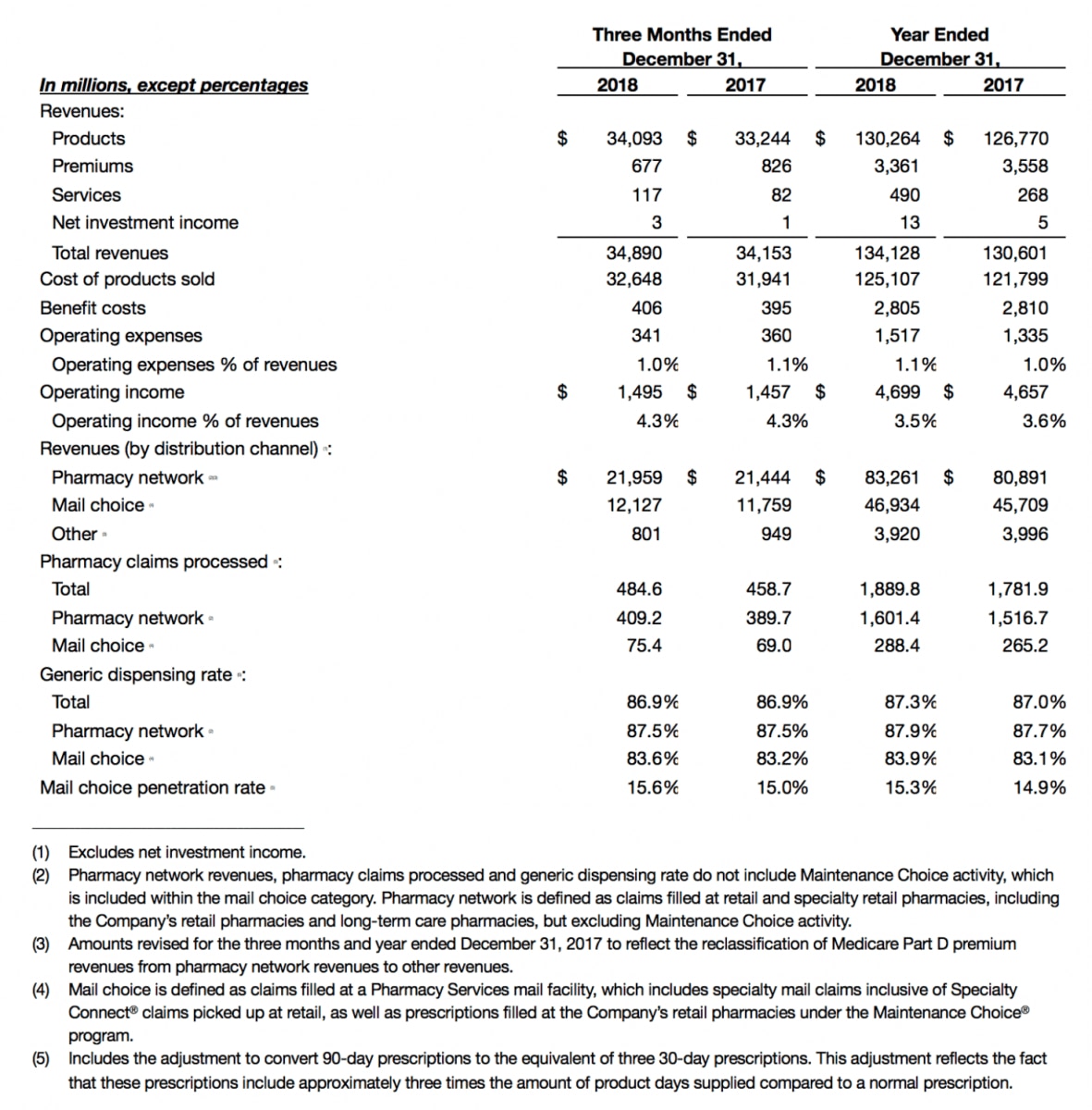
-
Revenues increased 2.2% and 2.7% in the three months and year ended December 31, 2018, respectively, compared to the prior year due to increased total pharmacy claims volume, partially offset by continued client pricing pressures.
-
Total pharmacy claims processed increased 5.6% and 6.1%, on a 30-day equivalent basis, in the three months and year ended December 31, 2018, respectively, compared to the prior year primarily driven by net new business and the continued adoption of Maintenance Choice® offerings.
-
Operating income increased 2.6% and 0.9% in the three months and year ended December 31, 2018, respectively, compared to the prior year driven by increased claims volume and improved purchasing economics, partially offset by continued pricing compression.
Refer to supplemental information on page 18 for additional information regarding the performance of the Pharmacy Services segment.
Retail/LTC Segment
The Retail/LTC segment fulfills prescriptions for medications, provides patient care programs, sells a wide-assortment of general merchandise, provides health care services through walk-in clinics and provides services to long-term care facilities. The segment results for the three months and years ended December 31, 2018 and 2017 are as follows:

- Revenues increased 5.4% and 5.8% in the three months and year ended December 31, 2018, respectively, compared to the prior year. The increase in revenues was primarily driven by increased prescription volume and branded drug price inflation, partially offset by continued reimbursement pressure and the impact of recent generic introductions.
- Front store revenues remain approximately 23% of total Retail/LTC segment revenues. Front store revenues increased in the three months and year ended December 31, 2018 compared to the prior year primarily driven by increases in health product sales.
- Total prescription volume grew 8.6% and 8.8%, on a 30-day equivalent basis, for the three months and year ended December 31, 2018, respectively, compared to the prior year. The growth was driven mainly by the continued adoption of patient care programs and collaborations with PBMs as well as preferred status in a number of Medicare Part D networks during 2018.
- Operating income (loss) for the three months and year ended December 31, 2018 reflects goodwill impairment charges of $2.2 billion and $6.1 billion, respectively, related to the LTC reporting unit (described further below). In addition to the goodwill impairment charges, the decline in operating income also was due to increased operating expenses as a result of the investment of a portion of the savings from the TCJA in wages and benefits.
- The LTC business has continued to experience industry wide challenges that have impacted our ability to grow the business at the rate that was originally estimated when the Company acquired Omnicare, Inc. in 2015. These challenges include lower occupancy rates in skilled nursing facilities, significant deterioration in the financial health of numerous skilled nursing facility customers which resulted in a number of customer bankruptcies in 2018, and continued facility reimbursement pressures. As a result of these challenges, a goodwill impairment charge of $3.9 billion was recorded during the second quarter of 2018. During the fourth quarter of 2018, the LTC reporting unit missed its forecast primarily due to operational issues and customer liquidity issues, including one significant customer bankruptcy. Additionally, LTC management submitted an updated final budget for 2019 which showed significant additional deterioration in the reporting unit’s projected financial results for 2019 compared to the analysis performed in the second quarter of 2018, primarily due to continued industry and operational challenges, which also caused management to make further updates to their long term forecast beyond 2019. Based on these updated financial projections, management determined that there were indicators that the goodwill of the LTC business may be further impaired, and accordingly, an interim goodwill impairment test was performed as of December 31, 2018. The results of the impairment test showed that the fair value of the LTC business was lower than the carrying value resulting in a $2.2 billion goodwill impairment charge. In addition to the lower financial projections, lower market multiples of the peer group companies contributed to the amount of the goodwill impairment charge.
Refer to supplemental information on page 19 for additional information regarding the performance of the Retail/LTC segment.
Health Care Benefits Segment
On November 28, 2018, CVS Health completed the acquisition of Aetna. The Health Care Benefits segment is equivalent to the former Aetna Health Care segment. The Health Care Benefits segment provides a full range of insured and self-insured (“ASC”) medical, pharmacy, dental and behavioral health products and services. The segment results for the period from November 28, 2018 to December 31, 2018 are as follows:

-
Revenues and operating income for the Health Care Benefits segment include results for the period from November 28, 2018 to December 31, 2018 and therefore are not directly comparable to the former Aetna Health Care segment results for the fourth quarter of 2017.
-
Medical membership as of December 31, 2018 remained relatively consistent compared with September 30, 2018, reflecting decreases in Commercial insured and Medicaid products, largely offset by increases in Commercial ASC and Medicare products.
Refer to supplemental information on page 20 for additional information regarding the performance of the Health Care Benefits segment.
2019 Guidance
The Company’s full year 2019 consolidated GAAP operating income is projected to be in the range of $11.7 billion to $12.1 billion while adjusted operating income is projected to be in the range of $14.8 billion to $15.2 billion. GAAP diluted EPS from continuing operations is projected to be in the range of $4.88 to $5.08, and Adjusted EPS is projected to be in the range of $6.68 to $6.88. The adjustments between GAAP operating income and GAAP diluted EPS from continuing operations and adjusted operating income and Adjusted EPS include adding back amortization of intangible assets and integration costs related to the acquisition of Aetna. The Company expects to continue to generate strong cash flows in 2019, with projected cash flow from operations between $9.8 billion and $10.3 billion.
Mr. Merlo added, “2019 will be a year of transition as we integrate Aetna and focus on key pillars of our growth strategy. We are fully aware of the need to address the impact of certain headwinds that are having a disproportionate impact in 2019 compared to prior years, and importantly, we are taking comprehensive actions to move past them. We understand acutely the importance of balancing near-term execution with longer-term vision, and we are confident that our actions will position us well in 2020 and beyond.”
Non-GAAP Financial Information
Adjusted Operating Income, Adjusted EPS and Free Cash Flow are non-GAAP financial measures. Reconciliations of each of these non-GAAP financial measures to the most directly comparable GAAP financial measure are presented in the tables later in this press release.
Teleconference and Webcast
The Company will be holding a conference call today for investors at 8:30 am (EST) to discuss its fourth quarter and full year results. An audio webcast of the call will be broadcast simultaneously for all interested parties through the Investor Relations section of the CVS Health website at http://investors.cvshealth.com. This webcast will be archived and available on the website for a one-year period following the conference call.
About the Company
CVS Health is the nation’s premier health innovation company helping people on their path to better health. Whether in one of its pharmacies or through its health services and plans, CVS Health is pioneering a bold new approach to total health by making quality care more affordable, accessible, simple and seamless. CVS Health is community-based and locally focused, engaging consumers with the care they need when and where they need it. The Company has more than 9,900 retail locations, approximately 1,100 walk-in medical clinics, a leading pharmacy benefits manager with approximately 92 million plan members, a dedicated senior pharmacy care business serving more than one million patients per year, expanding specialty pharmacy services, and a leading stand-alone Medicare Part D prescription drug plan. CVS Health also serves an estimated 38 million people through traditional, voluntary and consumer-directed health insurance products and related services, including rapidly expanding Medicare Advantage offerings. This innovative health care model increases access to quality care, delivers better health outcomes and lowers overall health care costs. Find more information about how CVS Health is shaping the future of health at https://www.cvshealth.com.
Cautionary Statement Regarding Forward-Looking Statements
The Private Securities Litigation Reform Act of 1995 provides a safe harbor for forward-looking statements made by or on behalf of CVS Health Corporation. Statements in this press release that are forward-looking include the information under the headings “2019 Guidance” and the related footnotes and reconciliations and the information in Mr. Merlo’s quoted statements. By their nature, all forward-looking statements involve risks and uncertainties. Actual results may differ materially from those contemplated by the forward-looking statements for a number of reasons as described in our Securities and Exchange Commission filings, including those set forth in the Risk Factors section and under the section entitled “Cautionary Statement Concerning Forward-Looking Statements” in our most recently filed Annual Report on Form 10-K and Quarterly Report on Form 10-Q.
You are cautioned not to place undue reliance on CVS Health’s forward looking statements. These forward-looking statements are and will be based upon management’s then-current views and assumptions regarding future events and operating performance, and are applicable only as of the dates of such statements. CVS Health does not assume any duty to update or revise forward-looking statements, whether as a result of new information, future events or otherwise, as of any future date.
- Tables Follow -
CVS HEALTH CORPORATION
Condensed Consolidated Statements of Operations
(Unaudited)
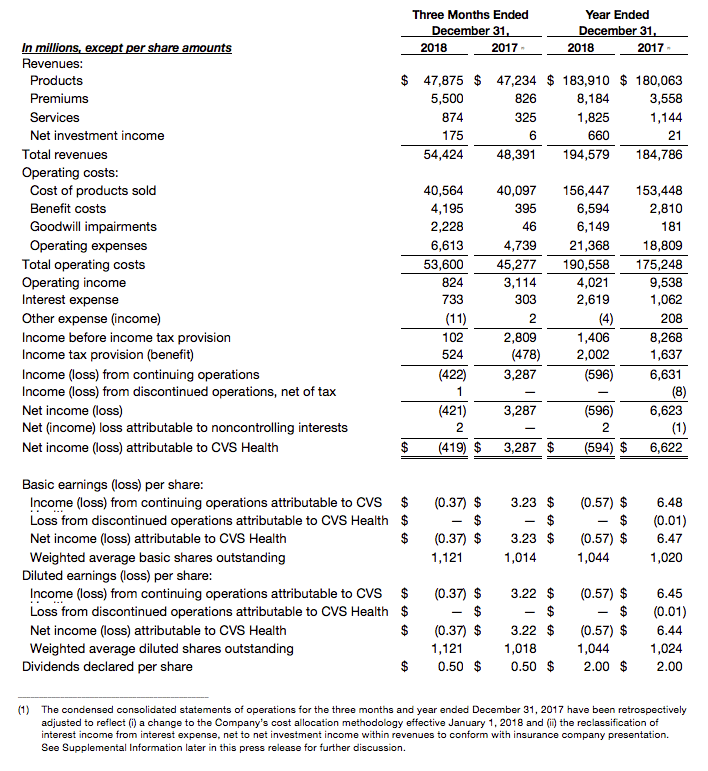
CVS HEALTH CORPORATION
Condensed Consolidated Balance Sheets
(Unaudited)
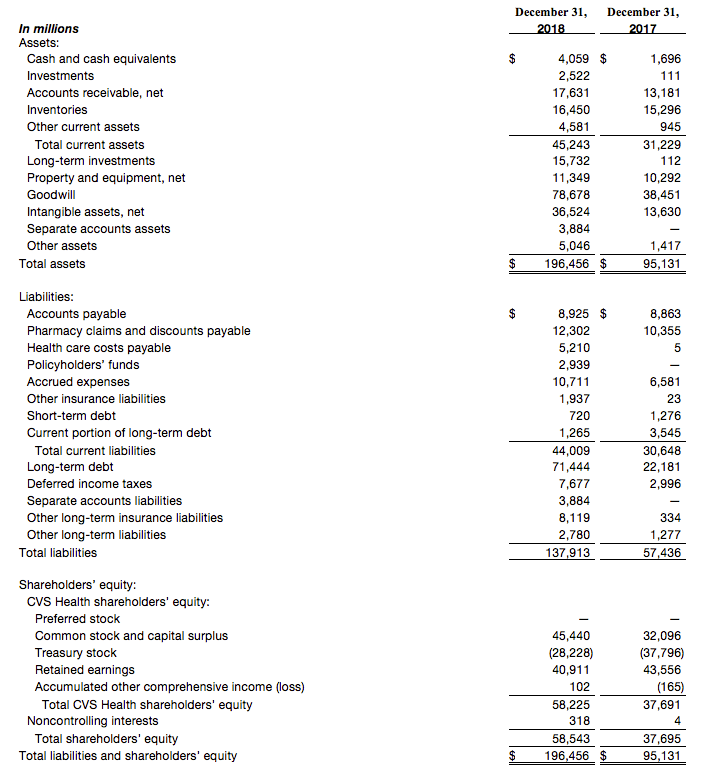
CVS HEALTH CORPORATION
Condensed Consolidated Statements of Cash Flows
(Unaudited)
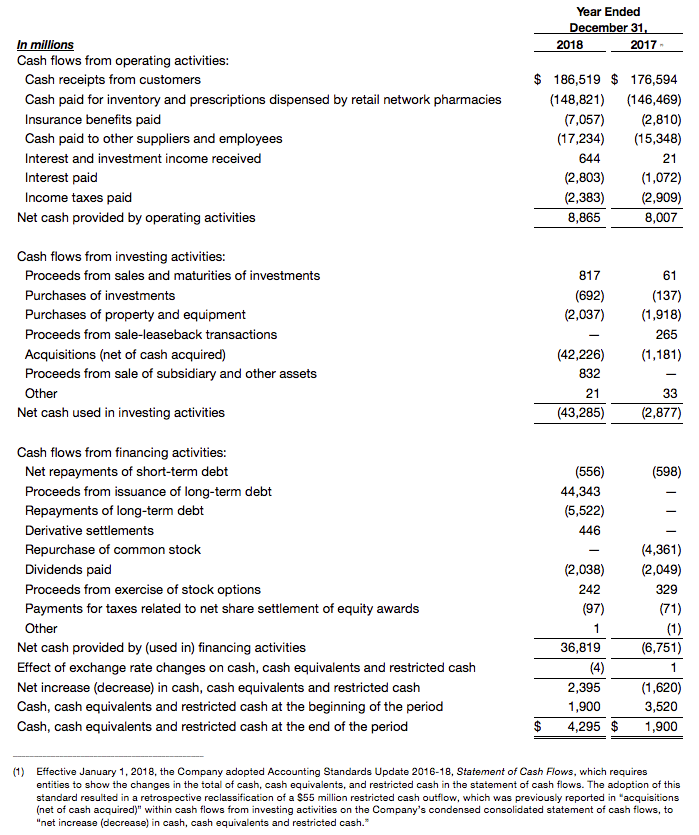
CVS HEALTH CORPORATION
Condensed Consolidated Statements of Cash Flows
(Unaudited)
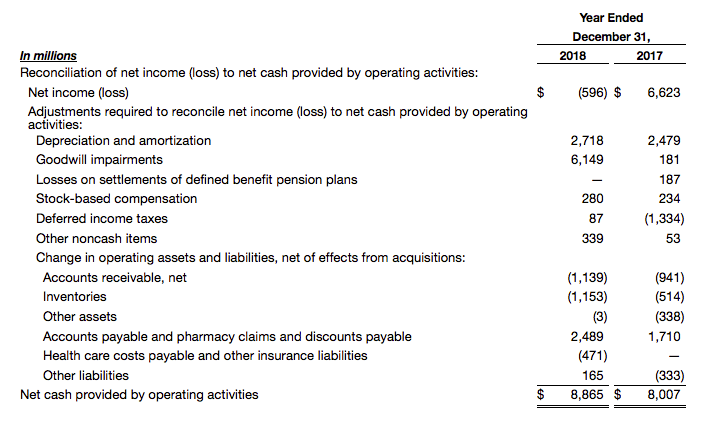
Non-GAAP Financial Measures
The following tables provide reconciliations of certain non-GAAP financial measures presented in this press release to the most directly comparable financial measures calculated and presented in accordance with GAAP. The Company is also providing reconciliations of certain non-GAAP information on a prospective basis. The Company uses the non-GAAP measures “Adjusted Operating Income,” “Adjusted EPS” and “Free Cash Flow” to assess and analyze underlying business performance and trends. Management believes that providing these non-GAAP measures enhances investors’ understanding of the Company’s performance.
For 2018 and 2017, the Company defines Adjusted Operating Income as operating income (GAAP measure) excluding the impact of certain adjustments such as acquisition-related transaction and integration costs, goodwill and long-lived asset impairments, gains/losses and transaction costs on divestitures, interest income on financing associated with proposed acquisitions (for periods prior to the acquisition), charges in connection with store rationalization, and any other items specifically identified herein. For 2019, the Company defines Adjusted Operating Income as operating income (GAAP measure) excluding the impact of certain adjustments such as the amortization of intangible assets, acquisition-related transaction and integration costs, goodwill and long-lived asset impairments, gains/losses and transaction costs on divestitures, interest income on financing associated with proposed acquisitions (for periods prior to the acquisition), charges in connection with store rationalization, and any other items specifically identified herein. Management believes that this non-GAAP measure enhances investors’ ability to compare past financial performance with its current and expected performance.
The Company defines Adjusted Earnings per share, or Adjusted EPS, as income before income tax provision (GAAP measure) excluding the impact of certain adjustments such as the amortization of intangible assets, acquisition-related transaction and integration costs, goodwill and long-lived asset impairments, gains/losses and transaction costs on divestitures, net interest expense on financing associated with proposed acquisitions (for periods prior to the acquisition), losses on settlements of defined benefit pension plans, charges in connection with store rationalization, and any other items specifically identified herein, divided by the Company’s weighted average diluted shares outstanding. Adjusted EPS for the three months and year ended December 31, 2018 is calculated utilizing weighted average diluted shares outstanding, which include 5 million and 3 million, respectively, potential common shares, as the impact of the potential common shares was dilutive. The potential common shares were excluded from the calculation of GAAP loss per share for the three months and year ended December 31, 2018, as the shares would have had an anti-dilutive effect as a result of the GAAP net loss incurred in both periods. Management believes that this non-GAAP measure enhances investors’ ability to compare the Company’s past financial performance with its current performance.
The Company defines Free Cash Flow as net cash provided by operating activities less net additions to property and equipment (i.e., additions to property and equipment plus proceeds from sale-leaseback transactions). Management uses this non-GAAP financial measure for internal comparisons and finds it useful in assessing year-over-year cash flow performance.
These non-GAAP financial measures are provided as supplemental information to the financial measures presented in this press release that are calculated and presented in accordance with GAAP. Adjusted Operating Income should be considered in addition to, rather than as a substitute for, operating income. Adjusted EPS should be considered in addition to, rather than as a substitute for, income before income tax provision as a measure of our performance. Free Cash Flow should be considered in addition to, rather than as a substitute for, net cash provided by operating activities as a measure of our liquidity. The Company’s definitions of Adjusted Operating Income, Adjusted EPS and Free Cash Flow may not be comparable to similarly titled measurements reported by other companies.
Adjusted Operating Income
(Unaudited)
The following is a reconciliation of operating income to adjusted operating income:
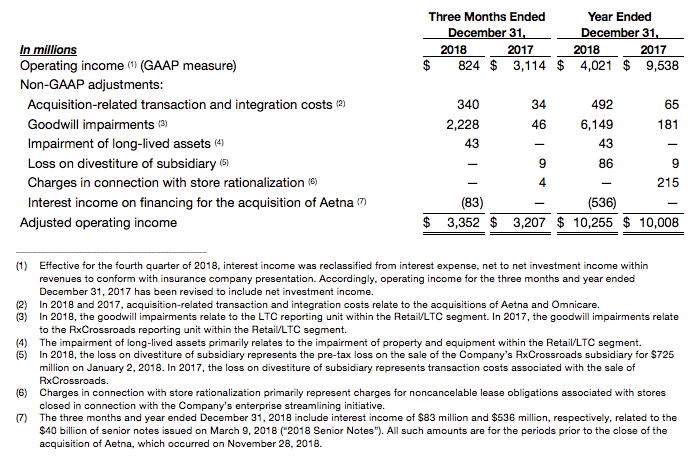
Adjusted Earnings Per Share
(Unaudited)
The following is a reconciliation of income before income tax provision to adjusted income from continuing operations attributable to CVS Health and a calculation of Adjusted EPS:
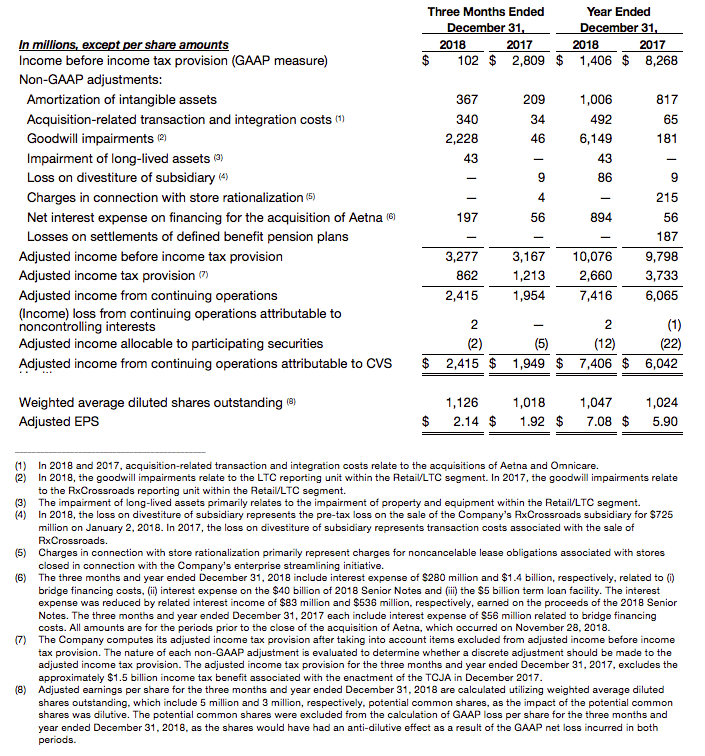
Free Cash Flow
(Unaudited)
The following is a reconciliation of net cash provided by operating activities to Free Cash Flow:

Supplemental Information
(Unaudited)
The Company evaluates its Pharmacy Services, Retail/LTC and Health Care Benefits segment performance based on operating income and operating income before the effect of nonrecurring charges and gains and certain intersegment activities.
In conjunction with the Company’s implementation of a new enterprise resource planning system in the first quarter of 2018, the Company changed the manner in which certain shared functional costs are allocated to its reportable segments. Additionally, in connection with the acquisition of Aetna on November 28, 2018, the Company reclassified interest income for the three months and year ended December 31, 2017 from interest expense, net to net investment income within revenues to conform with insurance company presentation. Segment financial information for the three months and year ended December 31, 2017, has been retrospectively adjusted to reflect these changes as shown below:
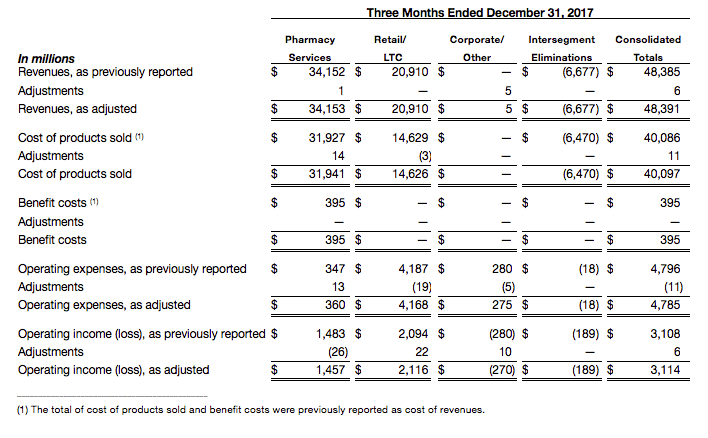
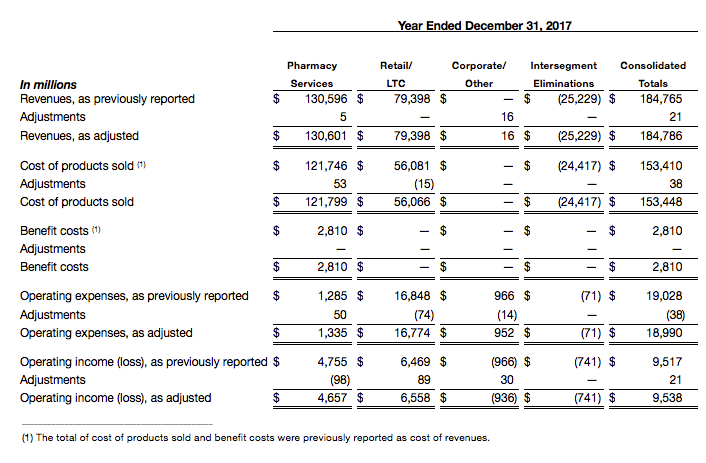
The following is a reconciliation of financial measures of the Company’s segments to the accompanying condensed consolidated financial statements:
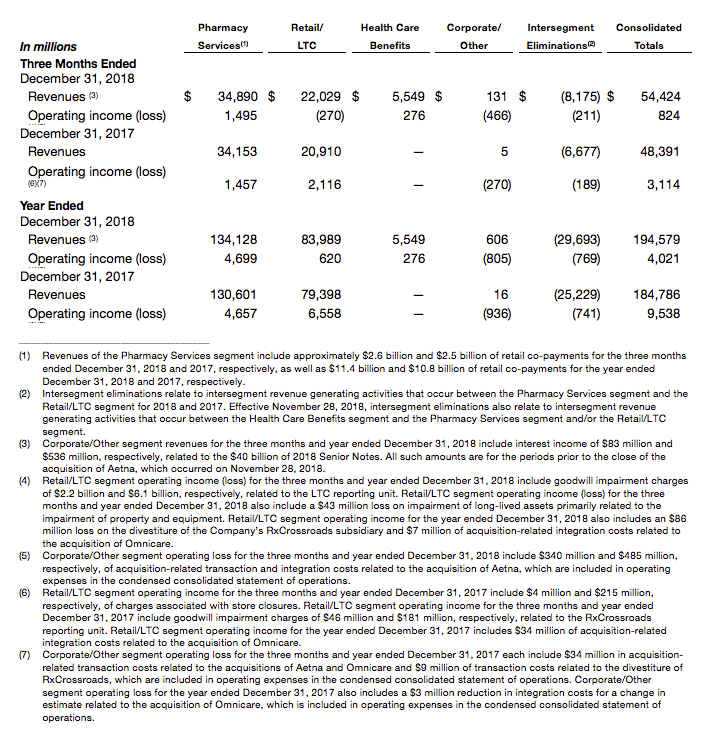
Supplemental Information
(Unaudited)
Pharmacy Services Segment
The following table summarizes the Pharmacy Services segment’s performance for the respective periods:

Supplemental Information
(Unaudited)
Retail/LTC Segment
The following table summarizes the Retail/LTC segment’s performance for the respective periods:
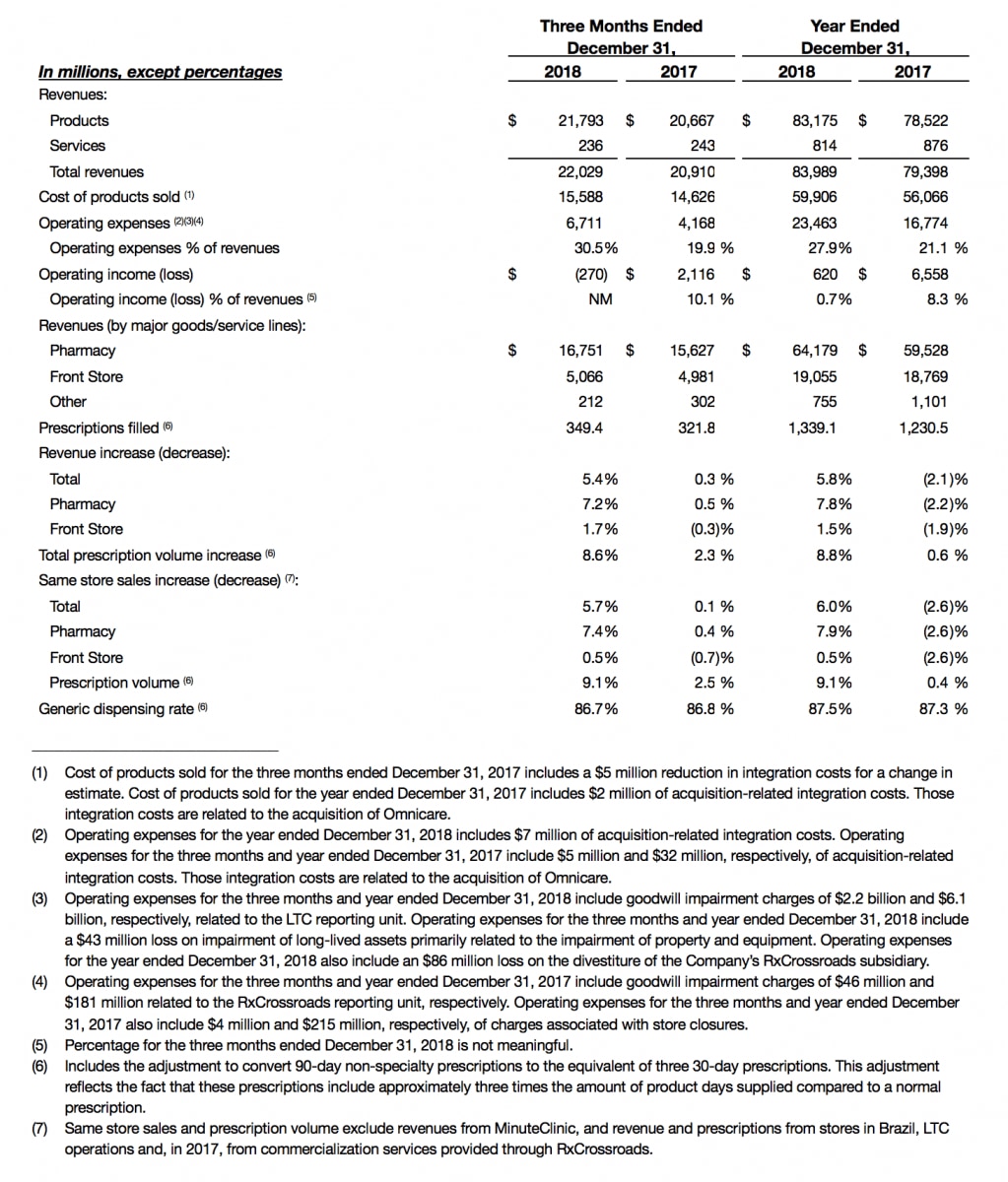
Supplemental Information
(Unaudited)
Health Care Benefits Segment
The following table summarizes the Health Care Benefits segment’s performance for the period from November 28, 2018 to December 31, 2018:

The following table summarizes the Health Care Benefits segment’s medical membership as of December 31, 2018:

Adjusted Operating Income Guidance
(Unaudited)
The following reconciliation of projected operating income to projected adjusted operating income contains forward-looking information. All forward-looking information involves risks and uncertainties. Actual results may differ materially from those contemplated by the forward-looking information for a number of reasons as described in our Securities and Exchange Commission filings, including those set forth in the Risk Factors section and under the section entitled “Cautionary Statement Concerning Forward-Looking Statements” in our most recently filed Annual Report on Form 10-K and Quarterly Report on Form 10-Q. See also previous discussion at “Non-GAAP Financial Measures” for more information on how we calculate Adjusted Operating Income.

Adjusted Earnings Per Share Guidance
(Unaudited)
The following reconciliation of projected income before income tax provision to projected adjusted income from continuing operations attributable to CVS Health and calculation of Adjusted EPS contains forward-looking information. All forward-looking information involves risks and uncertainties. Actual results may differ materially from those contemplated by the forward-looking information for a number of reasons as described in our Securities and Exchange Commission filings, including those set forth in the Risk Factors section and under the section entitled “Cautionary Statement Concerning Forward-Looking Statements” in our most recently filed Annual Report on Form 10-K and Quarterly Report on Form 10-Q. See also previous discussion at “Non-GAAP Financial Measures” for more information on how we calculate Adjusted EPS.
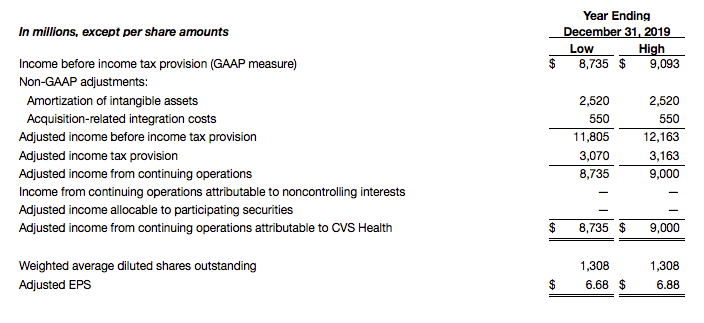
Investor Contact:
Mike McGuire
Senior Vice President
Investor Relations
(401) 770-4050
Media Contact:
T.J. Crawford
Vice President
External Affairs
(212) 457-0583